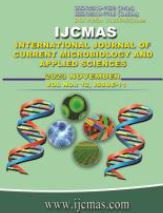


 National Academy of Agricultural Sciences (NAAS)
National Academy of Agricultural Sciences (NAAS)

|
PRINT ISSN : 2319-7692
Online ISSN : 2319-7706 Issues : 12 per year Publisher : Excellent Publishers Email : editorijcmas@gmail.com / submit@ijcmas.com Editor-in-chief: Dr.M.Prakash Index Copernicus ICV 2018: 95.39 NAAS RATING 2020: 5.38 |
Wound infections caused by drug-resistant Proteus species pose a global health threat, including in Nigeria. This study aimed to determine the prevalence, antibiotic susceptibility, and ESBL production in Proteus species from wound infections in a Nigerian tertiary hospital. The descriptive cross-sectional study spanned eight months (September 2022 to April 2023) at Alex-Ekwueme Federal University Teaching Hospital in Ebonyi State, Nigeria. 322 wound samples from in and out-patients were analyzed using disc diffusion for antimicrobial susceptibility, the double disc-synergy test for phenotypic ESBL production, and PCR for ESBL gene screening. Out of the 322 samples, 61 (18.9%) were Proteus species, with 43 (70.5%) identified as Proteus mirabilis and 18 (29.5%) as Proteus vulgaris. Surgical wounds had the highest number of Proteus isolates (41%), followed by wound ulcers (34.4%), and trauma wounds had the least (24.68%). The relationships between wound type and Proteus prevalence, patient category and Proteus prevalence, and age of patients and Proteus prevalence were not statistically significant (p > 0.05). However, the relationship between patients' sex and Proteus prevalence was significant, with males (73.8%) having higher isolates than females (26.2%). Ceftazidime and levofloxacin showed the highest activity against Proteus isolates, while nalidixic acid, cefotaxime, imipenem, and nitrofurantoin exhibited the highest resistance. There were significant differences in antibiotic sensitivity and resistance between P. mirabilis and P. vulgaris (p < 0.05). 80% of Proteus isolates were multidrug-resistant (MDR), and this relationship was statistically significant (p < 0.05). 55% of P. mirabilis and 55.6% of P. vulgaris were confirmed to produce ESBLs. PCR detected ESBL genes: TEM (37.5%), CTX-M (37.5%), and SHV (25.0%). Proteus isolates from the studied wound infections demonstrated a high level of multidrug resistance, and ESBL genes were detected.
 |
 |
 |
 |
 |